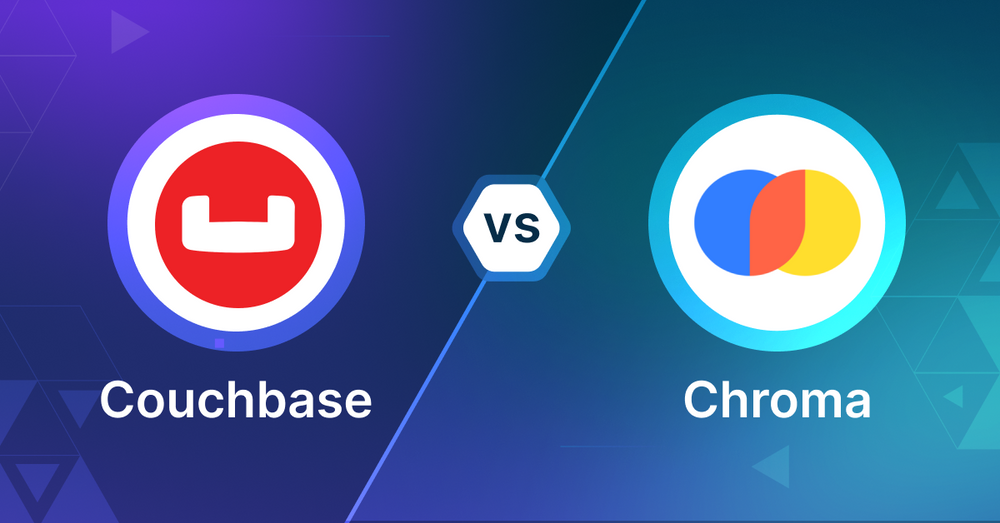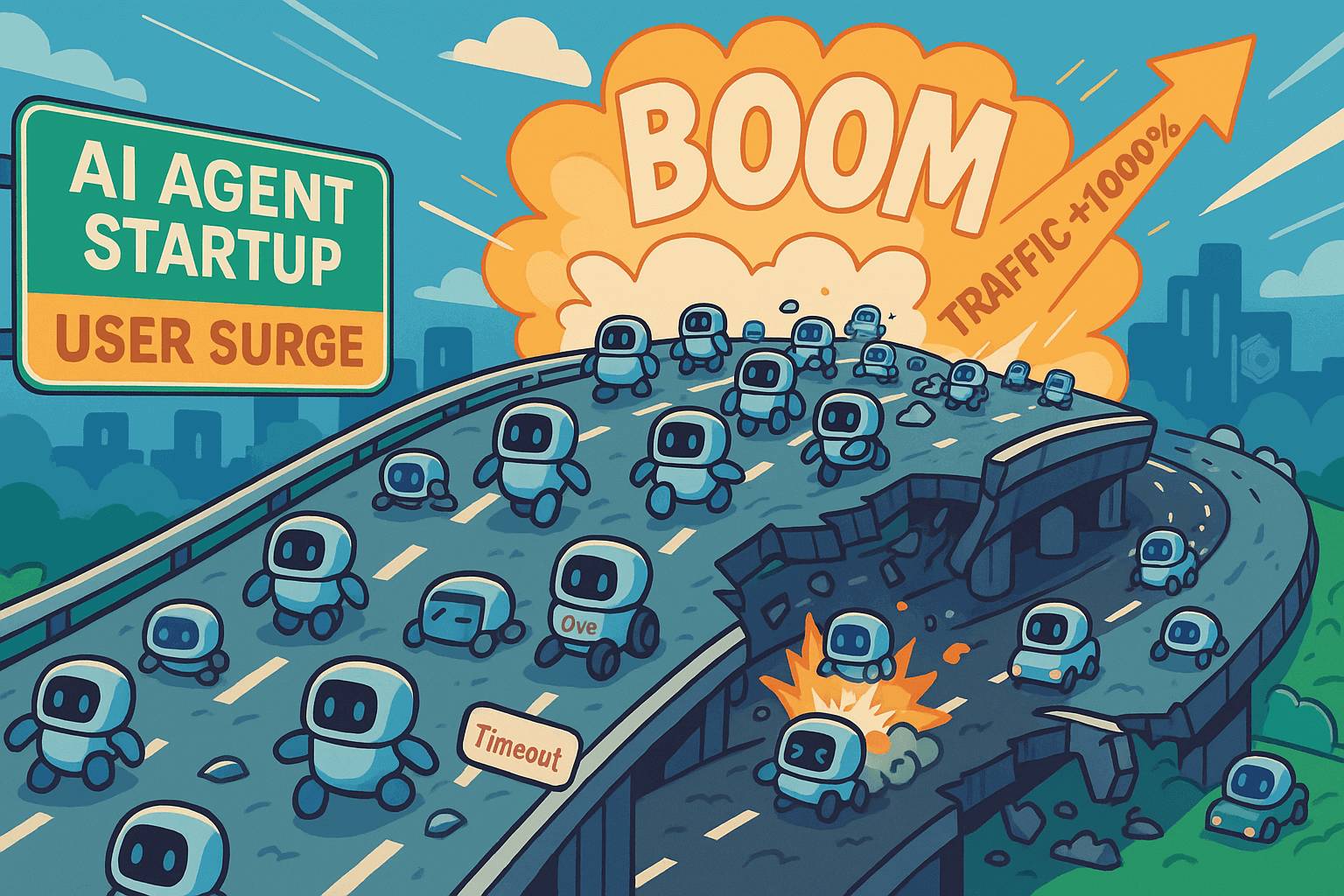Couchbase vs Chroma Choosing the Right Vector Database for Your AI Apps

What is a Vector Database?
Before we compare Couchbase and Chroma, let's first explore the concept of vector databases.
A vector database is specifically designed to store and query high-dimensional vectors, which are numerical representations of unstructured data. These vectors encode complex information, such as the semantic meaning of text, the visual features of images, or product attributes. By enabling efficient similarity searches, vector databases play a pivotal role in AI applications, allowing for more advanced data analysis and retrieval.
Common use cases for vector databases include e-commerce product recommendations, content discovery platforms, anomaly detection in cybersecurity, medical image analysis, and natural language processing (NLP) tasks. They also play a crucial role in Retrieval Augmented Generation (RAG), a technique that enhances the performance of large language models (LLMs) by providing external knowledge to reduce issues like AI hallucinations.
There are many types of vector databases available in the market, including:
- Purpose-built vector databases such as Milvus, Zilliz Cloud (fully managed Milvus)
- Vector search libraries such as Faiss and Annoy.
- Lightweight vector databases such as Chroma and Milvus Lite.
- Traditional databases with vector search add-ons capable of performing small-scale vector searches.
Couchbase is distributed multi-model NoSQL document-oriented database with vector search capabilities as an add-on. Chroma is a vector dataabse. This post compares their vector search capabilities.
Couchbase: Overview and Core Technology
Couchbase is a distributed, open-source, NoSQL database that can be used to build applications for cloud, mobile, AI, and edge computing. It combines the strengths of relational databases with the versatility of JSON. Couchbase also provides the flexibility to implement vector search despite not having native support for vector indexes. Developers can store vector embeddings—numerical representations generated by machine learning models—within Couchbase documents as part of their JSON structure. These vectors can be used in similarity search use cases, such as recommendation systems or retrieval-augmented generation both based on semantic search, where finding data points close to each other in a high-dimensional space is important.
One approach to enabling vector search in Couchbase is by leveraging Full Text Search (FTS). While FTS is typically designed for text-based search, it can be adapted to handle vector searches by converting vector data into searchable fields. For instance, vectors can be tokenized into text-like data, allowing FTS to index and search based on those tokens. This can facilitate approximate vector search, providing a way to query documents with vectors that are close in similarity.
Alternatively, developers can store the raw vector embeddings in Couchbase and perform the vector similarity calculations at the application level. This involves retrieving documents and computing metrics such as cosine similarity or Euclidean distance between vectors to identify the closest matches. This method allows Couchbase to serve as a storage solution for vectors while the application handles the mathematical comparison logic.
For more advanced use cases, some developers integrate Couchbase with specialized libraries or algorithms (like FAISS or HNSW) that enable efficient vector search. These integrations allow Couchbase to manage the document store while the external libraries perform the actual vector comparisons. In this way, Couchbase can still be part of a solution that supports vector search.
By using these approaches, Couchbase can be adapted to handle vector search functionality, making it a flexible option for various AI and machine learning tasks that rely on similarity searches.
Chroma: Overview and Core Technology
Chroma is an open-source, AI-native vector database that simplifies the process of building AI applications. It acts as a bridge between large language models (LLMs) and the data they require to function effectively. Chroma's main objective is to make knowledge, facts, and skills easily accessible to LLMs, thereby streamlining the development of AI-powered applications. At its core, Chroma provides tools for managing vector data, allowing developers to store embeddings (vector representations of data) along with their associated metadata. This capability is crucial for many AI applications, as it enables efficient similarity searches and data retrieval based on vector relationships.
One of Chroma's key strengths is its focus on simplicity and developer productivity. The team behind Chroma has prioritized creating an intuitive interface that allows developers to quickly integrate vector search capabilities into their applications. This emphasis on ease of use doesn't come at the cost of performance. Chroma is designed to be fast and efficient, making it suitable for a wide range of applications. It operates as a server and offers first-party client SDKs for both Python and JavaScript/TypeScript, providing flexibility for developers to work in their preferred programming environment.
Chroma's functionality revolves around the concept of collections, which are groups of related embeddings. When adding documents to a Chroma collection, the system can automatically tokenize and embed them using a specified embedding function, or a default one if not provided. This process transforms raw data into vector representations that can be efficiently searched. Along with the embeddings, Chroma allows storage of metadata for each document, which can include additional information useful for filtering or organizing data. Chroma provides flexible querying options, allowing searches for similar documents using either vector embeddings or text queries, returning the closest matches based on vector similarity.
Chroma stands out in several ways. Its API is designed to be intuitive and easy to use, reducing the learning curve for developers new to vector databases. It supports various types of data and can work with different embedding models, allowing users to choose the best approach for their specific use case. Chroma is built to integrate seamlessly with other AI tools and frameworks, making it a good fit for complex AI pipelines. Additionally, Chroma's open-source nature (licensed under Apache 2.0) provides transparency and the potential for community-driven improvements and customizations. The Chroma team is actively working on enhancements, including plans for a managed service (Hosted Chroma) and various tooling improvements, indicating a commitment to ongoing development and support.
Key Differences
When building AI applications, the choice of vector search solution impacts both your development experience and application performance. Let’s compare Couchbase and Chroma across key areas to help you decide.
Search Methodology
Couchbase has several ways to do vector search, but no native vector search. You can do vector search by using Full Text Search (FTS) and converting vectors into searchable fields, or by storing raw vectors and doing similarity calculations in your application code. Or you can integrate external vector search libraries like FAISS or HNSW. This flexibility comes at a cost of extra implementation work.
Chroma takes a different approach with its built-in vector search capabilities. It does vector operations natively and manages the embedding for you. This means less setup work and faster vector search in your applications.
Data
Couchbase is a NoSQL database that stores JSON documents, combining traditional database features with modern JSON flexibility. Vector embeddings are part of your JSON documents, so it’s suitable for applications that need both traditional database operations and vector search. This hybrid approach allows for complex data models and many query patterns.
Chroma is focused on AI workloads and vector operations. It stores vector data and metadata in collections with automatic embedding generation. This specialization makes it great for AI applications that work primarily with vector data, but not for applications that need broader database functionality.
Scalability and Performance
Couchbase has a distributed architecture that supports horizontal scaling and has a proven track record in large scale deployments. But vector search performance depends on your implementation. You may need to optimize your vector operations separately and performance will vary based on your setup and configuration.
Chroma brings vector operation optimization out of the box, so you get fast similarity search without extra tuning. While performance at scale is still being proven in production, the team is actively working on performance improvements. The system is designed to be efficient for vector specific tasks.
Flexibility and Customization
Couchbase provides a lot of flexibility for database operations, so you can do vector search in multiple ways. You can combine traditional queries with vector operations, but this flexibility comes with more setup and configuration work. The system lets you customize your vector search implementation to your needs, but you’ll need to manage those customizations yourself.
Chroma simplifies vector operations while being flexible where it matters most. You can customize embedding functions and metadata storage, but the system only does vector related operations. This focused approach makes it easier to implement and maintain vector search, but might feel restrictive if you need broader database functionality.
Integration and Ecosystem
Couchbase works across cloud, mobile and edge computing environments and has a large ecosystem for traditional database operations. Vector search requires extra integration work, but the platform is compatible with many vector search libraries so you have options for different use cases. This flexibility comes at the cost of more complex integration.
Chroma has native Python and JavaScript/TypeScript SDKs so it’s easy to integrate with AI tools and frameworks. It’s designed for Large Language Models, but its ecosystem is smaller than Couchbase. This specialization means easier integration for AI specific tasks but more work for broader application requirements.
Making Your Choice
For teams that need a general purpose database with vector search, Couchbase is the full solution. It’s great if you already use Couchbase infrastructure or need traditional database features alongside vector search. The platform lets you implement vector search the way that’s best for your use case.
Chroma is for teams that are primarily focused on AI and vector search operations. Its fast path to implementation and automatic embedding means less development time and complexity. It’s great for new AI applications where vector search is a core requirement not an add on.
Cost and Security
The cost model is very different between the two. Couchbase is an enterprise licensed model with higher operational costs but has enterprise grade security features. Chroma is open source, so lower initial cost but may have hosting costs in the future through its managed service. Its security features are evolving and currently has basic features for smaller deployments.
Decide based on your needs, resources and long term plans. Start with Chroma if vector search is your main requirement and you want a fast path to implementation. Start with Couchbase if you need a full database platform that can scale with your application’s broader needs beyond vector search.
When to Choose Couchbase
Couchbase is for applications that need traditional database features and vector search. It’s for enterprise applications that handle multiple data types, need strong security and distributed scaling. Choose Couchbase when your app needs to support mobile and edge computing and vector search or when you need flexible deployment options across cloud and on-premises. It’s for teams that can invest time in setting up vector search implementations and need a mature database that can handle complex queries, transactions and vector operations in one place.
When to Choose Chroma
Chroma is for teams building AI-first applications where vector search is the top priority. It’s for projects that need vector search up and running quickly, especially those working with Large Language Models or building semantic search features. Choose Chroma when you want to minimize setup time, need automatic embedding generation and don’t need complex traditional database features. It’s for startups and teams that prioritize developer productivity over customization options or building prototypes and AI applications that are all about similarity search and retrieval.
Conclusion
The choice between Couchbase and Chroma comes down to your app’s focus and your team’s priorities. Couchbase is a full-featured database that can include vector search capabilities, with enterprise features, strong security and proven scalability. Chroma is simple and vector focused, perfect for AI-first applications that need to get up and running fast. Your decision should balance development resources, scaling needs, security requirements and whether vector search is primary or secondary in your app. Choose Couchbase when you need a full-featured database with vector capabilities and choose Chroma when you want a vector search only solution.
While this article provides an overview of Couchbase and Chroma, it's key to evaluate these databases based on your specific use case. One tool that can assist in this process is VectorDBBench, an open-source benchmarking tool designed for comparing vector database performance. Ultimately, thorough benchmarking with specific datasets and query patterns will be essential in making an informed decision between these two powerful, yet distinct, approaches to vector search in distributed database systems.
Using Open-source VectorDBBench to Evaluate and Compare Vector Databases on Your Own
VectorDBBench is an open-source benchmarking tool designed for users who require high-performance data storage and retrieval systems, particularly vector databases. This tool allows users to test and compare the performance of different vector database systems such as Milvus and Zilliz Cloud (the managed Milvus) using their own datasets and determine the most suitable one for their use cases. Using VectorDBBench, users can make informed decisions based on the actual vector database performance rather than relying on marketing claims or anecdotal evidence.
VectorDBBench is written in Python and licensed under the MIT open-source license, meaning anyone can freely use, modify, and distribute it. The tool is actively maintained by a community of developers committed to improving its features and performance.
Download VectorDBBench from its GitHub repository to reproduce our benchmark results or obtain performance results on your own datasets.
Take a quick look at the performance of mainstream vector databases on the VectorDBBench Leaderboard.
Read the following blogs to learn more about vector database evaluation.
Further Resources about VectorDB, GenAI, and ML
- What is a Vector Database?
- Couchbase: Overview and Core Technology
- Chroma: Overview and Core Technology
- Key Differences
- When to Choose Couchbase
- When to Choose Chroma
- Conclusion
- Using Open-source VectorDBBench to Evaluate and Compare Vector Databases on Your Own
- Further Resources about VectorDB, GenAI, and ML
Content
Start Free, Scale Easily
Try the fully-managed vector database built for your GenAI applications.
Try Zilliz Cloud for FreeKeep Reading

Why Not All VectorDBs Are Agent-Ready
Explore why choosing the right vector database is critical for scaling AI agents, and why traditional solutions fall short in production.

Vector Databases vs. Document Databases
Use a vector database for similarity search and AI-powered applications; use a document database for flexible schema and JSON-like data storage.

Top 5 AI Search Engines to Know in 2025
Discover the top AI-powered search engines of 2025, including OpenAI, Google AI, Bing, Perplexity, and Arc Search. Compare features, strengths, and limitations.
The Definitive Guide to Choosing a Vector Database
Overwhelmed by all the options? Learn key features to look for & how to evaluate with your own data. Choose with confidence.